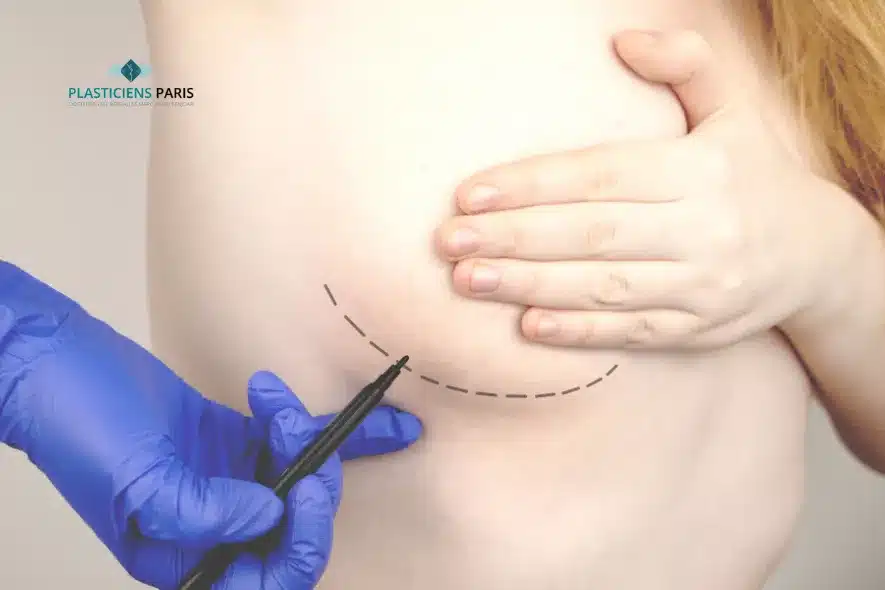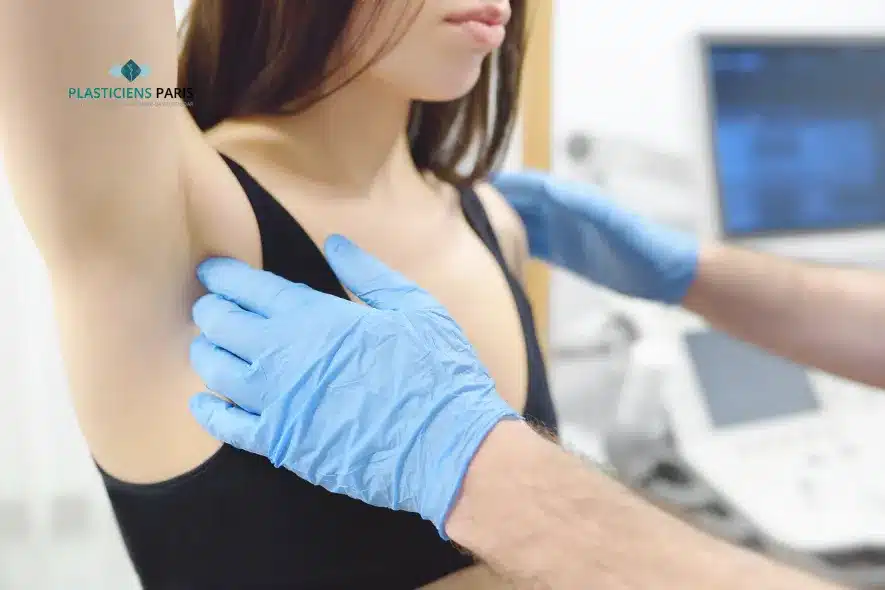Breast reconstruction or breast cancer surgery
Breast reconstruction after breast cancer is an option for restoring body integrity, figure and self-confidence. This surgical procedure can be performed after mastectomy (radical treatment of breast cancer) or lumpectomy (conservative treatment of breast cancer), and results vary according to the techniques employed. It is suitable for women who wish to regain aesthetic and functional breasts after the disease.
When to have breast reconstruction after breast cancer?
Immediate breast reconstruction
Breast reconstruction can be performed either immediately, at the time of mastectomy (immediate reconstruction), or at a later date (deferred reconstruction). In our team, we favor immediate reconstruction wherever possible, including for patients requiring additional treatments such as chemotherapy or radiotherapy. Thanks to advanced techniques and appropriate management, over 95% of patients can benefit from this approach.
Opting for immediate reconstruction offers several advantages: it allows you to achieve an aesthetic result without waiting, and limits the psychological impact of breast loss. The procedure, performed in the same operating time as the mastectomy, preserves the figure and facilitates acceptance of the body transformation.
Delayed breast reconstruction
However, each patient's journey is unique. For those who have already undergone a mastectomy or lumpectomy at another facility, we also offer deferred reconstruction. This personalized approach enables us to meet each patient's specific needs, taking into account her medical history and expectations.
Breast reconstruction after mastectomy: what are the options in your case?
Several reconstruction techniques are available for breast reconstruction after breast cancer surgery. The choice depends on a number of factors, including aesthetic expectations, the type of cancer, the breast surgery performed and the patient's morphology.
Breast prosthesis reconstruction
The most common method of breast reconstruction using prostheses in France involves inserting an implant under the chest muscles, whether for immediate or delayed reconstruction. However, this option has certain limitations: prostheses do not tolerate radiotherapy well, which can lead to complications in patients requiring this treatment.
What's more, this reconstruction is not definitive and may require additional procedures, such as breast lipofilling to improve volume, or implant replacement due to wear and tear over time.
Flap breast reconstruction
This technique is based on the use of autologous tissue, i.e. tissue taken from the patient's own body (stomach, back, buttocks), to reconstruct the breast.
The advantages of flap reconstruction
It offers a more natural result, with a texture and suppleness close to that of a natural breast.
It can be performed immediately after mastectomy or at a later date, depending on the patient's situation.
Unlike implants, it withstands radiotherapy well, making it a preferred option for patients requiring heavy treatment (chemotherapy, radiotherapy).
The reconstructed breast evolves with the body: it's warm, lively and follows weight variations, offering better long-term harmony.
The result is stable and does not require replacement or specific follow-up as with prostheses.

The result is stable over time and requires no prosthesis inspection or replacement.
Disadvantages of flap reconstruction
The main disadvantage of this technique is the need to harvest tissue from elsewhere on the body, resulting in additional scarring. The choice of harvesting site depends on the patient's morphology, and must provide sufficient volume while minimizing the aesthetic impact of the scar.
Flap breast reconstruction techniques
Our team offers three types of flap adapted to the morphology and specific needs of each patient.
The DIEP/SIEA flap (taken from the abdomen)
The DIEP flap breast reconstruction technique is ideal for women with excess tissue below the navel, often after pregnancy. It enables one or both breasts to be reconstructed naturally, using only skin and fat, without damaging the abdominal muscles. The scar is discreetly placed under the panties, limiting the aesthetic impact.
The major drawback of this technique is the need to reconnect an artery and a vein under a microscope (microsurgery), a painstaking and time-consuming procedure. However, this method is considered the " Gold Standard " in breast reconstruction, offering long-lasting results and a rendering close to the natural breast.
The PAP flap (taken from under the buttock)
This type of reconstruction is preferred by slim women who lack sufficient abdominal tissue. It involves harvesting a small fold of skin and fat under the buttock (banana roll), along with an artery and vein located at the back of the thigh.
The procedure does not damage the muscles and leaves a discreet scar hidden in the buttock crease. However, as the volume removed is more limited, this technique is best suited to patients with B or C cup breasts. The microsurgery used is even more delicate than for DIEP, requiring highly specialized expertise.
The TDAP or back fold flap
This option is suitable for women with a significant dorsal skin fold, or when microsurgery is difficult or impossible. Unlike the previous technique of breast reconstruction using a dorsalis major flap, which involved harvesting an entire muscle and led to painful after-effects, the TDAP flap does not damage the musculature of the back.
The surgeon dissects an artery and vein through the muscle to the armpit, allowing the tissue to be rotated to reconstruct the breast without the need for microsurgery. The main drawback of this method is that the amount of fat transferred is often insufficient, requiring additional lipomodelling sessions to achieve optimal volume.
Lipomodelage and other complementary breast reconstruction procedures
Lipomodelling of the breast (breast lipofilling)
Lipofilling breast reconstruction involves taking fat from another area of the body (stomach, thighs, flanks) and injecting it into the reconstructed breast. This technique improves aesthetics by refining contours and adding volume, particularly after reconstruction with a prosthesis or flap.
In some cases, complete breast reconstruction using exclusive lipomodelling is possible, but cannot be performed immediately after mastectomy. This is because the fat graft, being a free graft, cannot survive in the space left empty by the removal of the breast. This technique requires between 3 and 5 operations spaced 3 months apart to enable progressive reconstruction and a harmonious result.
Breast harmonization
When the unaffected breast is not symmetrical to the reconstructed one, an additional operation, such as a breast reduction or a facelift, can be performed to improve symmetry. This operation can be performed at the time of reconstruction or at a later date.
Breast reconstruction after lumpectomy
Breast reconstruction is also possible after lumpectomy. If sufficient tissue remains after tumor removal, reconstruction can be performed using lipomodelling or an implant. Sometimes, symmetrization of the unaffected breast may be necessary to ensure greater harmony. The choice of technique depends on the amount of tissue available and the patient's aesthetic expectations.
For more information on breast reconstruction, post-operative care or our prices, please contact our secretariat.

Breast reconstruction: how does the procedure work?
Breast reconstruction is generally performed in several stages. If it is immediate, it is performed during the same operation as the mastectomy and can last between 2 and 8 hours, depending on the technique.
The main stages are :
- Surgical site preparation: removal of remaining breast tissue or fat harvesting for lipomodelling
- Implant insertion or tissue transfer: placing the implant or repositioning the tissue taken to reconstruct the breast.
- Symmetrization: if necessary, adjustment of the remaining breast for better harmony
- Areola and nipple reconstruction: performed a few months later, often using medical tattooing techniques.
The number of procedures varies according to the technique chosen, and several stages, spaced several months apart, may be necessary to finalize the reconstruction.
Convalescence after breast reconstruction
Recovery time after breast reconstruction depends on the technique chosen. In general, hospitalization lasts a few days, depending on the complexity of the operation.
After the operation, it is common to experience moderate pain, well controlled by painkillers. Post-operative care is necessary to avoid infection and ensure proper healing.
It takes around 6 to 8 weeks to return to normal activity. However, some patients will need to avoid strenuous exercise for several months.
Follow-up with the surgeon is instituted to monitor healing progress and detect any complications.
Breast reconstruction prices: rates and coverage
Part of the cost of breast reconstruction is reimbursed by the Assurance Maladie under the 100% plan, including additional procedures to harmonize the breasts or reconstruct the nipple.
However, the patient may still have to pay for certain expenses, particularly if the practitioner is in sector II or charges a free fee. In this case, the mutual insurance company may supplement the coverage, depending on the contract taken out.
To find out more about the price of breast reconstruction, please consult our price list.
Breast reconstruction in case of breast malformation
Plastic surgery is used to treat breast deformities, whether congenital (present at birth or appearing during development) or acquired (mainly related to a breast infection or the after-effects of surgery). Here too, autologous techniques have taken on a predominant role, notably the injection of purified fat or lipofilling. The following conditions can be treated in this way:
- Breast asymmetry: It is possible that one breast develops and not the other. In this case, the treatment includes a volume increase of the underdeveloped breast and sometimes a volume decrease of the overdeveloped breast.
- Tuberous breasts: The breast does not develop in its lower part because of a congenital fibrous ring that stops its growth. It then has an unsightly tubular appearance. The treatment is based on fat injections followed eventually by an implant
- Poland syndrome: this is a malformative syndrome that associates a lack of breast development with hypotrophy of the pectoralis major muscle. Its treatment is based on fat injections.
Cure or surgery for invaginated nipples: treatment can be medical or surgical
- Sequelae of breast surgery: the removal of benign tumors (adenofibroma), breast abscesses, complications from breast implants, can cause significant deformities of the breast. Here again, the treatment is most often based on lipofilling.
Areola and nipple reconstruction:
Nipple and areola reconstruction is the final stage of total breast repair after mastectomy. We use an original technique that avoids the need to harvest a skin graft from the root of the thigh.
Have a question? Please contact us!
Cosmetic surgery in Paris
Docteur Yaël Berdah and Docteur Marc-David Benjoar
Plastic surgeons in Paris France
